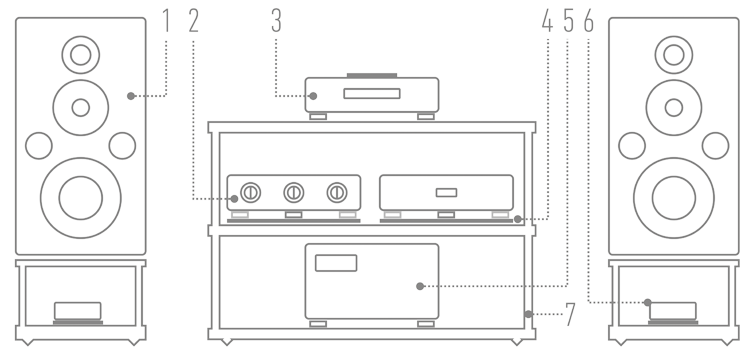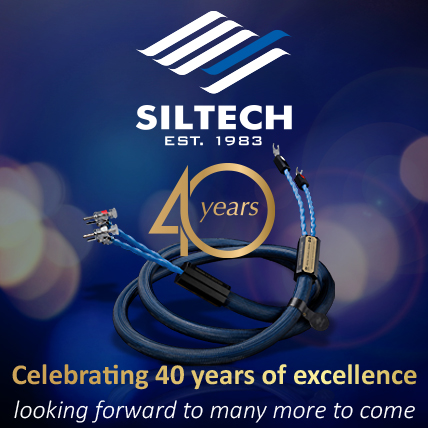|
POWER CONDITIONER AC Gigawatt
Manufacturer: P.A. LABS. |

|
Review
text by WOJCIECH PACUŁA |

|
No 248 January 1, 2025 |
|
˻ PREMIERE ˼
CELEBRATING the HIGH FIDELITY’S 20th anniversary, I felt like, on the one hand, it had been really long time, and on the other hand, that it passed incredibly fast. Which is (almost) always true. I guess that’s what Adam Szubert felt like last year when his P.A.Labs, owner of the Gigawatt brand (the name is stylized as GigaWatt) celebrated its 25th anniversary, a quarter of a century! 
We met with Adam some twenty-three years ago, shortly after he launched the Powerbox and PowerAC power conditioners, then still sold under the Power Audio Laboratories brand. Since then, his products have come a long way and found their place in the global audio market as an integral, important part of it. Today, it comes as no surprise to anyone that power conditioners, power strips and cables with the Gigawatt logo are found in top systems at every major audio show. How best to celebrate such an anniversary? - In audio, it's almost always an opportunity to present either the best or a special product. In the case of this Polish company, we received both, although not simultaneously. During last year's High-End Show in Munich, an event taking place between May 18th and 21st, the company's new top conditioner, the Powermaster model, was officially presented (more → HERE ˻PL˺). It was premiered and tested in the September issue of “High Fidelity” and was featured on our cover. It was a completely new design, based on a new approach to the design of its products. It, along with the simultaneous launch of its flagship conditioner model was therefore noticed and widely reported. Expectations were very high, especially since the manufacturer wrote about its new product that it was its “best, most advanced design, and the perfect crowning achievement of the company's 25-year history.” As you can read in the test we cited, all of the claims were fulfilled, and the device was awarded the GOLD FINGERPRINT, → STATEMENT AWARD 2024 ˻PL˺, and was also included in our “20 for XX” list with the top 20 Polish products in the history of our magazine; more → HERE. Such a hat-trick happens extremely rarely. Probably it wasn't supposed to be like this, however... It took another year or more for the “proper” birthday product, the Powermaster 25th Anniversary Edition, to be ready. Externally and internally, it is very similar to the basic model but differs from it in several important elements. And it is a limited-edition product. | A few simple words… ADAM SZUBERT 
⸜ ADAM SZUBERT with the „anniversary” power conditioner presenting two types of conductive rails - standard copper and silver-plated copper ones UPON COMPLETING THE POWERMASTER PROJECT, which is likely to be our flagship conditioner for a long time, we planned to produce a short series, to highlight our 25th anniversary. Following the principle that even the perfect can be improved, we wanted these limited versions to differ by more than just the “anniversary” addition to the name. So what is the difference between the limited anniversary version of the PowerMaster and the standard one? Looking at the device both from the outside and inside, the differences could basically be summed up in two words - MORE COPPER! This slogan is revealed by the conditioner's exterior right from the start, especially the copper POWERMASTER - 25TH ANNIVERSARY EDITION logo seen on the ceramic glass window, and the plaque located on the rear panel. The anniversary version, also features a unique front, made of anodized aluminum in GRAPHITE color. 
⸜ And here they are, the new conductive rails made of silver-plated copper used for 25th Anniversary version As for the interior, the most spectacular feature is the main distribution rails, connecting the various filter branches. They are made of silver-plated OFC copper bars with a cross-section of 225 QMM! This is the largest size that can be used in this design. Together with silver-plated 6 QMM cross-section OFC copper cables insulated with Teflon, we took care of extreme lossless current flow and maximum vibration reduction. In the Anniversary version, in order to better dissipate heat from the active element of the DCB block, we used heatsinks with a copper finish. We also managed to perfectly equipotentialize all filtering circuits. In the standard version, all filtering elements of the conditioner rest on an anti-vibration platform made of a special non-magnetic steel alloy, which is suspended on shock absorbers. In the Anniversary version, it is replaced by a platform made of pure OFC copper. Due to the excellent conductivity of copper, it provides perfect electrical potential equalization for each filter circuit. 
⸜ DC-blocking circuits of the AC supply voltage received copper heat sinks, better cooling the interior In addition to the ideal electrical properties of the new copper platform, the design also benefits from its unique mechanical properties. Copper is a material that suppresses the amplitude of adverse vibrations much better than any other metal. This unique property of the new platform, together with the ceramic feet, forms the comprehensive anti-vibration isolation of this special limited series. AS ▌ Powermaster 25th Anniversary Edition POWERMASTER 25th ANNIVERSARY EDITION is an AC power conditioner, a development version of the basic Powermaster model. The latter is Gigawatt's flagship product and, as we have read, is expected to stay in that position for a long time. The two versions are very similar in design, but they differ in selected design elements. So the following description will be based on the one we prepared for the test of the basic model of the conditioner, taking into account the introduced changes. FRONT AND REAR •The conditioner features as many as twelve output sockets, grouped into three jointly filtered groups, four in each. Its chassis is extremely rigid. It was assembled in a similar way as is done in very good audio amplifiers, namely from aluminum plates. The upper wall was additionally dampened with bituminous mat. In turn, the front glass of the display is made of scratch-resistant 9H ceramic glass. Unlike the basic model, it bears the inscription certifying the anniversary status of the device. Under the glass, a three-position LED-type digital voltmeter is located on the aluminum front panel, which has a slightly different appearance than in its previous products. This is new to its products, a precision TRUE-RMS voltmeter, with a measurement accuracy of <±0.5%. It is supposed to be, in the manufacturer's words, “a rugged design with isolated inputs, resistant to distortion and measurement error caused by higher harmonics.” He goes on to say, “It does not independently generate any interference that could degrade the quality of the power supply filtered by the conditioner.” Several color versions of the display are available, and it can be turned off with a small button on the bottom panel. INSIDE •The view of the interior is excellent, it is truly world class in terms of planning and execution. As the manufacturer writes, the Powermaster uses a new internal circuit architecture. The device features a block structure. It is a two-stage power distribution system, which is the company's own development. It is based on massive distribution rails made of polished bars of silver-plated, oxygen-free OFHC C10100 copper of 99.997% purity. The first stage is designed to allow even distribution of voltage to the individual filter branches, while the second stage delivers current directly to each pair of output sockets via crimp and screw connections and wiring made with 4 mm2 silver-plated oxygen-free copper conductors insulated with Teflon FEP. At the input, just behind the IEC inlet with a phase failure indicator, there is a mechanical switch. Behind it, there is a DC-Blocker module, suppressing the DC component of the AC supply voltage. Bolted to its plate are the three, already mentioned, bars, which supply current to the filter modules. There are three modules, with one for every four output sockets. This makes it possible to isolate three different groups of devices from each other, for example, high-current (amplifiers), low-current (preamplifiers) and digital. Other filtering elements are also connected to the bars, in parallel with these modules; all said modules are shielded. These solutions, the manufacturer assures, have resulted in “stable flow and handling of high currents up to 100A continuously” and “up to 500A at peak.” This is ensured by the new distribution buses of the filter modules. Already in the basic version they had a very large cross-section, 90 QMM, now increased to as much as 225 QMM, the largest possible value, as Adam said earlier. There you can also see compensation batteries with a “power factor improvement function.” In previous top conditioners, these batteries were manufactured by the Polish company Miflex to Gigawatt's specifications, and the same is true here. The same company, also to the conditioner manufacturer's specifications, made the filter capacitors. Multi-point terminals have been used to mount cables to printed circuit boards, offering, the manufacturer says, very low electrical resistance (less than 200 μOhm), very high current carrying capacity for continuous and peak currents (up to 300 A), and an extremely strong mechanical connection between the terminal and the board. The connectors are supported by larger non-magnetic screws than before, allowing tightening to a torque of 2.5 Nm. The braided OFHC copper cables bear the Gigawatt logo and are custom-made for this manufacturer. The PCBs themselves are “ultra-strong”, made of 4OZ Heavy-Copper with “extremely thick layers of copper with extreme cross-sectional area,” which is said to give “powerful conduction and minimized losses.” The conductive layers of the PCBs and distribution rails are coated with a thick layer of precious metal compositions with “extreme conductivity.” The whole thing rests on an internal anti-vibration platform of copper suspended by shock absorbers. A ground noise filtering system has also been added to the package to eliminate ground interference. The conditioner stands on new anti-vibration feet with the company's proprietary name Full Ceramic Isolation System. These feature fully ceramic ZrO2 rolling bearings with zirconium balls and rings (with properties harder than steel). They resemble the designs of another Polish company, Pro Audio Bono (more → HERE). 
Let's add that we get Gigawatt's top-of-the-line power cable, 2 meters long LS-2 EVO, terminated with a 20 A plug with rhodium-plated contacts. On the other side, it is terminated with a Shuko plug manufactured for Gigawatt, with a turned aluminum housing. In the middle you can see a thickening - it's an aluminum piece meant to control vibration. It is a multi stand design. Each bundle consists of seven thinner conductors forming a twisted pair with a total cross-section of 1.5 mm2. The conductors are made of silver-plated 5N-purity oxygen-free copper, manufactured to GigaWatt's specifications. Above the power socket of the conditioner we find an excellent hydraulic-magnetic circuit breaker from Carling Technologies, which is custom-made in the USA to the specifications of the Polish manufacturer. This element acts as a circuit to control the value of current flowing through the internal circuits and as the main breaker of the conditioner. ▌ SOUND ˻ HOW WE LISTENED ˺ The test consisted of comparing the tested conditioner, along with its power cable (I treat these two components as a whole) to a reference system consisting of a power strip → Acoustic Revive RTP-4EU ABSOLUTE and a 2.5m Acrolink Mexcel 7N-PC9500 power cable. Both power cables - ones supplying the GigaWatt power conditioner and the Acoustic Revive strip - were plugged into Furutech FT-SWS (R) wall sockets. They are star-connected and run a separate power line, with Oyaide Tunami cable, from a separate AHP Klangmodul III fuse. 
There is consensus on the adverse effect of mechanical vibrations on the conducted current; these distortions are called triboelectric. That's why the Powermaster's designers spent so much time designing the chassis, the internal damping, and decoupling of circuits, as well as its high-end anti-vibration feet. I also agree with this opinion, which is why for many years I used the company's RST-38H platform under the Acoustic Revive strip, and a while back it was replaced by the revolutionary Graphite Audio Classic 100 Ultra platform (test → HERE). The Powermaster also stood on it. |
During the test, I switched the power supply to the entire “High Fidelity” reference system, that is: the Ayon Audio CD-35 HF Edition SACD player, the Ayon Audio Spheris III preamplifier and the Soulution 710 power amplifier. These devices are powered - respectively - by following power cables: Harmonix X-DC350M2R Improved-Version and 2 x Acoustic Revive Absolute Power Cord. On the rear panel of the conditioner there is a socket for grounding, which I took advantage of by connecting the Nordost QKore artificial ground to it (test → HERE). &» RECORDINGS USED FOR THE TEST ⸜ a selection
⸜ PAT METHENY, What's It All About, Nonesuch. Records/Warner Music Japan WPCR-14176, CD ⸜ 2011. IT IS NOT EASY TO ACKNOWLEDGE, it is really not!, that something we get to test, and I say this on behalf of specialized journalists, is better than our reference products. The more expensive our reference products are, the better they put together the sound in our system, the harder such honesty comes. It's happened to me a few times, for example with amplifiers such as → NAIM STATEMENT and → KONDO ONGAKU and cables → SILTECH MASTER CROWN. And a few more times, though not in an equally comprehensive way. 
However, when you come across something like this, you have to give credit where credit is due. That's why, with clenched teeth, and yet with great joy, I have to say that Gigawatt's anniversary power conditioner is better than the Acoustic Revive power strip I can't part with for years. Not by a little, not in some respect, but simply better overall. Also slightly different, which I will come back to later, but here and now I can say: this is an excellent conditioner, the best in the history of this company and one of the top few of its kind in the world. When I played ˻ 7 ˺ Black Magic Woman, a cover of Santana's song featured on PATRICIA BARBER's album Companion, I momentarily “entered” this mode of thinking. Because the Hammond organ, which the artist plays here, was shown on a much wider, much deeper and much better laid out soundstage. Please note - I use “much...” every time - and not without reason. The Polish conditioner does something similar with the sound, which I have to deal with when going from a very good CD or SACD player to an excellent player. Lately I have had a similar experience with the best file players, by the way. It's a sort of instantaneous knowledge, some subconscious and some fully realized, but generally instantaneous. Even before I start analyzing what I hear I know that there is something in the sound that I haven't heard in my system before. I think that it comes down, generally, to resolution. That's why the Hammonds with the Gigawatt sounded in a much wider space and surrounded me more strongly - it was shifted slightly in phase by the sound engineer. Also, percussion instruments, such as bells, rattles, etc., all of them were clearer and better placed in space. The latter, by the way, is much larger than with any power system I've had. The Gigawatt spreads instruments deep and wide, anchoring them in place by showing their meatiness. These are not points in space, but a coherent space with various elements in it. The change gave me a very similar, if not stronger, impression when I played PAT METHENY's album entitled What's It All About. It's just one guitar, but with long reverbs. And it was the reverbs that were so amazing. The instrument seemed to play louder than with the reference power strip, which made the reverbs stronger as well. But after all, I was listening to the pieces with exactly the same volume level as before, right? So it wasn't a matter of increasing the volume level of the sound, but of making it more energetic - something that is not shown in classical measurements. It was stronger, deeper and more energetic playing. And not by hardening the attack or brightening it. It was about a kind of “boosting” of the presentation as a whole. It was as if, well that's how I heard it, someone had turned up the sound by one, maybe even two decibels. This seems to be due to the stronger “presence” of the instruments. As if they are in our room “more”. As if more of them fit in our room than before. The reference strip, and another excellent conditioner, → THUNDER MELODY GRAAL BLACK https://highfidelity.pl/@main-1251&lang=en , present recordings in a darker way. But not because the Gigawatt is brighter. The latter simply shows a larger spectrum of sound, is how I see it. The Thunder Melody provides a darker, more velvety background, better even than the reference strip, which excels at it. But it's the Powermaster in the anniversary version that offers more information about the instrument itself, about the vocals. Yes, it's all about resolution and the fact that with the Gigawatt, the lowest level information is better integrated into the music, it's also, quite simply, clearer. Like the tape noise accompanying MARIA NAKAMOTO's recordings on Mari Nakamoto III, recorded with ISAO SUZUKI and KAZUMI WATANABE. The Three Blind Mice label did not use Dolby noise reduction at the time of the recordings, accepting its slightly higher level, but avoiding the problems associated with its use. And that very noise was stronger and clearer with the Powermaster 25th Anniversary. But this did not make it any more annoying. You see, one of the amazing properties of analog tape is that tape noise is extremely “physiological” and, kept in check, is not treated by the listener as a flaw. It's even a quality, adding authenticity to the presentation. And that's why I'm talking about it - no one listens to noise, after all, that's clear. However, the tested conditioner showed that it is an element that is an important component of recordings, and that in a properly resolving system it is distinct, yet natural. | Our Albums Series ⸜ QUEEN Queen I Impulse!/Universal Classics & Jazz UCGQ-9032 
MORE THAN HALF A CENTURY FROM THE PREMIERE and an important chapter in the band's history, Queen's 1973 debut album has been remixed and restored by Justin Shirley-Smith, Joshua J. Macrae, and Kris Fredriksson to, as the press materials read, “sound the way the band always wanted it to.” A new track list, alternate takes, demos and live tracks are expected to create “the most complete version of this pivotal work.” This is the first time that a Queen album has received a new stereo mix. “This is no ordinary remaster,” writes Brian May in the CD insert, ”it's a brand new 2024 restoration of Queen's entire debut album, which in retrospect we have re-titled QUEEN I.” May continues: “All of the songs are exactly as they were originally released in 1973, but every instrument has been re-mastered to get the 'live' ambient sounds we wanted to use originally. The result is Queen I, which sounds, due to use of current knowledge and technology, as if it had been recorded for the first time.” 
You do remember that multitrack tape mixing is one of the paths taken by publishers these days, right? They want, on the one hand, to improve the sound of classic recordings, and on the other hand, to re-sell the same material. As I wrote in my review of JOHN LENNON's album Mind Games (The Ultimate Mixes), this trend, that is, remixes, has a long history. Steven Wilson has been remixing King Crimson albums for years, Depeche Mode's entire catalog was remixed in 2004, and similar work on The Beatles albums was done by GILES MARTIN, son of George Martin, the band's longtime producer; more → HERE. For the first time, however, we get a remix of a Queen album. And maybe it's a good thing that they didn't start with the “sure thing”, but with the album which sounded the worst. In a bright, jazzy and low-resolution way. As Brian May recalls, although they recorded the album at the excellent studio, Trident, they did it with in-house co-producers John Anthony and Roy Thomas Baker. And those didn't exactly allow the band to realize the full potential of the place. 
It only takes a moment to realize that this is an excellent album. As it seems, its poor sound has been the reason why it was often overlooked, even by fans of the band. Now we get a sound that is dense and low, and above all with excellent tonal balance. It is also harmonically dense and quite dynamic. There's a bit of a problem with dynamics, but it's not so bad. Well, and it's very internally dense playing with an excellent soundstage. A truly resurrected, excellent sound! ● I'VE BEEN WAITING FOR THE QUEEN’S Queen I CD in a new remix nervously. I'd heard snippets of it on Tidal, and yet what I heard from the SHM-CD version from Japan exceeded my expectations of what it might sound like. The thing is, its original version always seemed to me too bright, jazzy, not very saturated. Now it's completely different. And the tested conditioner only highlighted these elements. The Acoustic Revive power strip played this material in a slightly darker way - this is the difference I mentioned at the beginning of the test. But even with such open and bit aggressive material as the one here, the Gigawatt did not show it in a bright way. Clear, resolving - ooo, yes. And what I said earlier about noise, that is, the conditioner's ability to extract fine information from the ‘dust’ of the recording, was confirmed at the beginning of the 3 ˺ Great King Rat . This piece begins with a hum (distortion) coming from the guitar amp over which a long reverb is superimposed. Immediately afterwards Brian May's powerful guitar enters, which masks the hum. With the Gigawatt both, the hum, and the guitar had a distinct character, but it was also clear that their source was the same device. These were not two random sounds that met on one track, but a believable image of a big guitar amp in a really big space. Along with the Queen CD from the → CD JAPAN store, came MILTON NASCIMENTO's CD entitled Courage. I don't know if you remember, but in the October issue of High Fidelity I shared with you my comments on this artist's latest CD, Milton + Esperanza, recorded with ESPERANZA SPALDING; more → HERE ˻PL˺. This is a remarkable document of the meeting of youth and experience. The eighty-two-year-old Brazilian singer, guitarist and composer today, was “discovered” in 1968 by Eumir Deodato, another musician from that country, who recommended him to jazz producer Creed Taylor, founder of the CTI and Impulse! recording labels. The first fruit of this collaboration was the Courage album. A beautiful cover, characteristic of the CTI label, and bossa nova at its best. Nascimento's vocals are given quite far on it, with reverb. Which Gigawatt momentarily pointed out. The Acoustic Revive power strip tends to bring sound sources closer and make them more plastic - they are supposed to be “here and now.” The conditioner we are testing works differently. It expands space, slightly distances the foreground and deeply builds the back of the stage. It doesn't do it by emphasizing details. I would even say that the sound is more silky and smooth with it than with the reference strip. The excellent resolution in question comes from the fact that there is more of everything with it. Maybe that's why the sound seems louder with the Gigawatt. ▌ Summary JUST AT THE END OF THE TEST, I realized that I haven't said much about the tonality. I think, probably because it is simply as good as it was with the Acoustic Revive strip. That is, evened out, well arranged, and the bandwidth is well extended. Because both the double bass from the Barber album, and Isao Suzuki's double bass, and Metheny's baritone guitar and, finally, May's electric guitar, all had a solid foundation, were meaty and energetic. 
And it is precisely that energy, coupled with resolution, or alertness to information, that produces such spectacular sound. No wonder Gigawatt conditioners can be found in top audio systems, not only at shows, but also in the real world. And the 25th Anniversary version is even more phenomenal in this respect. It's simply a top high-end that doesn't need any award - and we don't want to multiply awards (the basic Powermaster version has received enough of them) - to shine and sparkle. ● » An affiliate link is included in the text → CD JAPAN ▌ Technical specifications (according to the manufacturer)
Available outlets: EU (Schuko), US (Nema 5-20R), AU (AS/NZS 3112) 
THIS TEST HAS BEEN DESIGNED ACCORDING TO THE GUIDELINES adopted by the Association of International Audiophile Publications, an international audio press association concerned with ethical and professional standards in our industry, of which HIGH FIDELITY is a founding member. More about the association and its constituent titles → HERE. |

|
Reference system 2024 |
|
 1) Loudspeakers: HARBETH M40.1 |REVIEW| 2) Line preamplifier: AYON AUDIO Spheris III Linestage |REVIEW| 3) Super Audio CD Player: AYON AUDIO CD-35 HF Edition No. 01/50 |REVIEW| 4) Stands (loudspeakers): ACOUSTIC REVIVE (custom) |ABOUT| 5) Power amplifier: SOULUTION 710 6) Loudspeaker filter: SPEC REAL-SOUND PROCESSOR RSP-AZ9EX (prototype) |REVIEW| 7) Hi-Fi rack: Hi-Fi rack: finite elemente MASTER REFERENCE PAGODE EDITION Mk II, more → HERE |
|

|
Cables Analog interconnect SACD Player - Line preamplifier: SILTECH Triple Crown (1 m) |ABOUT|» ANALOG INTERCONNECT Line preamplifier → Power amplifier: Siltech ROYAL SINLGE CROWN RCA; review → HERE Speaker cable: SILTECH Triple Crown (2.5 m) |ABOUT| |

|
AC Power Power cable | Mains Power Distribution Block - SACD Player: SILTECH Triple CrownPower (2 m) |ARTICLE| » POWER CABLE Mains Power Distribution Block → Line preamplifier: Acoustic Revive ABSOLUTE-POWER CORD, review → HERE » POWER CABLE Mains Power Distribution Block → Power amplifier: Acoustic Revive ABSOLUTE-POWER CORD, review → HERE Power cable | Power Receptacle - Mains Power Distribution Block: ACROLINK Mexcel 7N-PC9500 (2 m) |ARTICLE| Power Receptacle: Acoustic Revive RTP-4eu ULTIMATE |REVIEW| » ANTI-VIBRATION PLATFORM under Acoustic Revive RTP-4eu ULTIMATE: Graphite Audio CLASSIC 100 ULTRA, review → HERE Power Supply Conditioner: Acoustic Revive RPC-1 |REVIEW| Power Supply Conditioner: Acoustic Revive RAS-14 Triple-C |REVIEW| Passive filter EMI/RFI: VERICTUM Block |REVIEW| |

|
Anti-vibration Speaker stands: ACOUSTIC REVIVE (custom)Hi-Fi rack: finite elemente MASTER REFERENCE PAGODE EDITION Mk II, more → HERE Anti-vibration platforms: ACOUSTIC REVIVE RAF-48H |ARTICLE| » ANTI-VIBRATIONAL FEET: |

|
Analogue Phono preamplifier: Phono cartridges:
Clamp: PATHE WINGS Titanium PW-Ti 770 | Limited Edition Record mats:
|

|
Headphones » HEADPHONE AMPLIFIER: Leben CS-600X, review → HEREHeadphones: Headphone Cables: Forza AudioWorks NOIR HYBRID HPC |
main page | archive | contact | kts
© 2009 HighFidelity, design by PikselStudio,
projektowanie stron www: Indecity

























